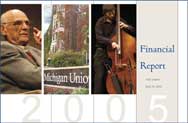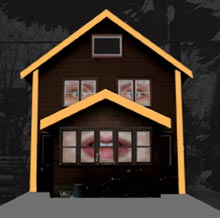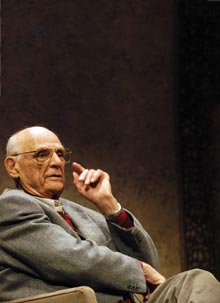

Mechanical Engineering student Evan Quasney believes he knows why the Mona Lisa’s smile keeps deteriorating. During an internship at the Smithsonian, Quasney studied preservation practices to help set new guidelines for how the Smithsonian stores art. As a result of his research, Quasney theorizes that applying a layer of gesso to the reverse side of panel paintings, such as the Mona Lisa that hangs in the Louvre, may reduce the tendency for the painting to warp and crack. Traditional methods of preservation, such as applying wood battens to the reverse, may actually cause more cracking. The Smithsonian’s senior research scientist, Marion Mecklenberg, says that the science-based findings may offend traditional art preservationists, but such computer modeling may change the way art is preserved in the future.
 A U-M Creative Writing Program graduate’s first novel debuted at No. 1 on the New York Times Bestseller list. Elizabeth Kostova’s (MFA ’04) novel, The Historian, tells the “backstory” of Dracula. She worked on the book for ten years, completing it during her years at U-M.
A U-M Creative Writing Program graduate’s first novel debuted at No. 1 on the New York Times Bestseller list. Elizabeth Kostova’s (MFA ’04) novel, The Historian, tells the “backstory” of Dracula. She worked on the book for ten years, completing it during her years at U-M.
Peter Ho Davies, the Helen Zell Director of the MFA in Creative Writing Program, hails Kostova’s auspicious debut. “It’s a remarkable achievement, unprecedented to my knowledge, for a first book in its initial week of release to go straight to No. 1,” he said.
The St. Petersburg String Quartet was in residence at the School of Music during the 2004–05 academic year. In addition to working with student composers, the renowned group presented a concert performing works by School of Music faculty Bright Sheng, Evan Chambers, and Susan Botti.
 Students from the School of Art and Design, along with Health Services, some units of the Michigan Student Assembly, and a Neighborhood Arts Committee (NAC), created a striking installation this year. “House Confessions: Vinyl Sidings Bring Good Tidings,” features Homie the Talking House, and encourages students to practice safe drinking and responsible party behavior. Homie has a history of bad partying experiences and likes to talk about them.
Students from the School of Art and Design, along with Health Services, some units of the Michigan Student Assembly, and a Neighborhood Arts Committee (NAC), created a striking installation this year. “House Confessions: Vinyl Sidings Bring Good Tidings,” features Homie the Talking House, and encourages students to practice safe drinking and responsible party behavior. Homie has a history of bad partying experiences and likes to talk about them.
Installed on the front, roof, and yard of a house near campus, illuminated screens depict a party scene, while a central screen encourages passersby to talk to Homie through a microphone that connects to a speaker inside. By focusing on Homie’s bad habits, students can contemplate their own. Homie also provides aid including water, food, a designated-driver service, and information on local services.
The NAC plans to take House Confessions to other college campuses nationwide.
 University of Michigan alumnus Arthur Miller died in his Connecticut home February 11, 2005, at the age of 89. He leaves behind a legacy of classic American theater works, including Death of a Salesman, The Crucible, and A View from the Bridge.
University of Michigan alumnus Arthur Miller died in his Connecticut home February 11, 2005, at the age of 89. He leaves behind a legacy of classic American theater works, including Death of a Salesman, The Crucible, and A View from the Bridge.
A native New Yorker, Miller worked at various jobs including truck driver, radio singer, and clerk in his father’s warehouse to earn funds for college. He came to Ann Arbor in the 1930s by bus with the $500 he had saved, and attended U-M with financial assistance from the National Youth Administration, which paid him $15 a month to feed mice in a cancer research lab. As a student, Miller also washed dishes for his meals and worked as night editor of the Michigan Daily. He graduated in 1938 with a degree in English.
Years later, Miller said he had been attracted to U-M because “tuition was cheap—about $60, I think—and I’d heard they gave Hopwood Awards to student writers. For a 19-year-old who knew he wanted to write, even though I didn’t know what I’d write, the fact that the University gave a dollar prize meant they took writing seriously here.” Miller eventually won two of the prestigious Hopwoods.
“For me [the U-M] was very welcoming, and I found it a very good environment for mixing with a lot of people I normally wouldn’t have met,” he wrote 15 years after graduation. “It was my idea of what a university should be. It was…the testing ground for all my prejudices, my beliefs, and my ignorance, and it helped to lay out the boundaries of my life.”
“The theatre is a lovely idea. I’ve resisted proposals from others, but it seems right from Ann Arbor.” – Arthur Miller, fall 1997

Plans for the new 250-seat Arthur Miller Theatre were approved in March by the Regents. Miller had reviewed the plans earlier with Music School Dean Karen Wolff.
The design was inspired by courtyard theater. Flexible seating and two stage options allow for several configuration choices. A shallow balcony helps create an intimate theater experience. “Arthur was most concerned about flexibility of the space and how our theater students would be able to try out different stagings,” Wolff said.
The theater will be located within the new Charles R. Walgreen, Jr. Drama Center, which will bring together offices and academic space from the departments of Theatre & Drama and Musical Theatre into facilities specifically designed for the dramatic arts.
In November, a Manhattan celebration of Arthur Miller’s career included showing proposed architectural renderings for the new theater. Alum and former Regent Robert Nederlander and his wife, Gladys, hosted the event with alum and Tony Award-winning Broadway producer Jeffrey Sellars. Graduates and faculty members of U-M’s School of Music brought Broadway, opera, dance, jazz, and classical violin to “Michigan on Broadway: A Tribute to Arthur Miller.”
“How better to honor the world’s finest playwright than for his alma mater to name a theater for him,” said Dean Wolff. “With the name ‘Arthur Miller’ on the building, future generations of U-M students and faculty will find inspiration in following their artistic pursuits.”